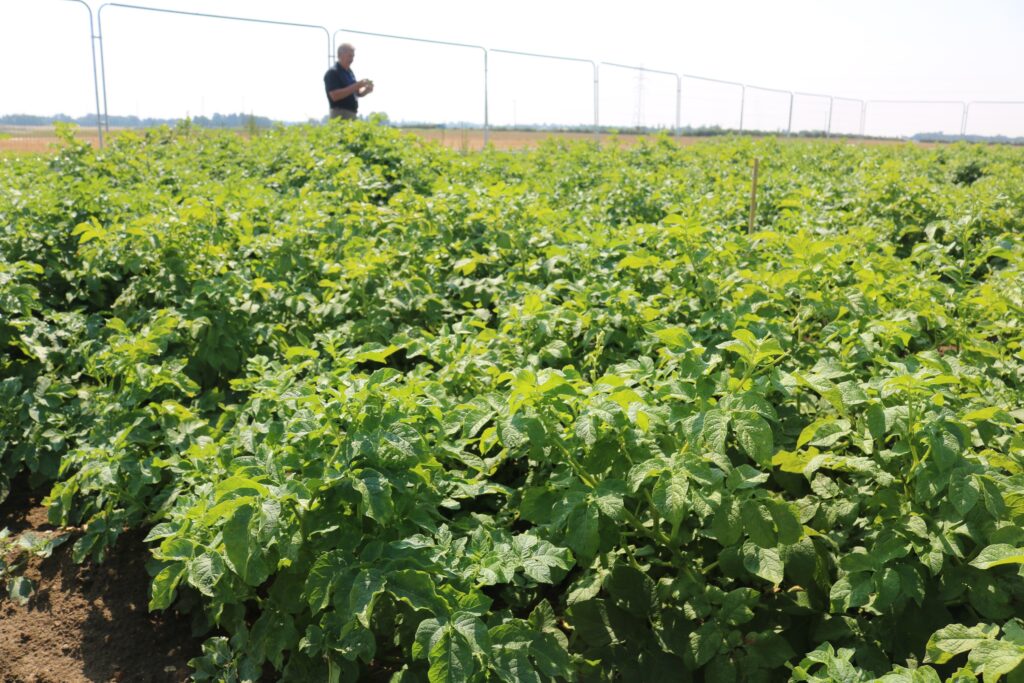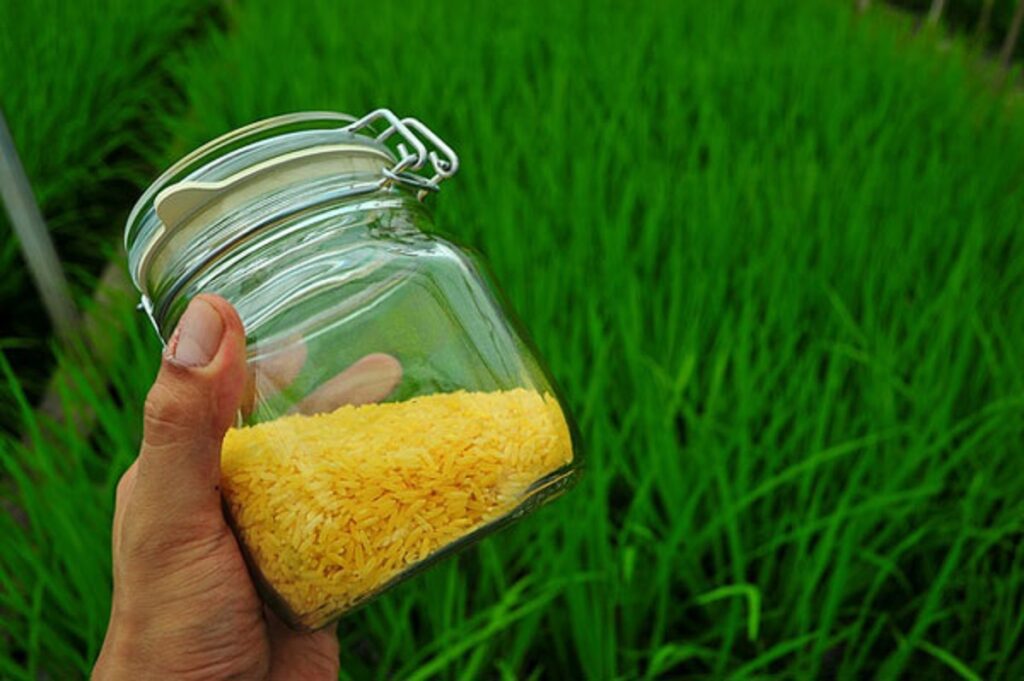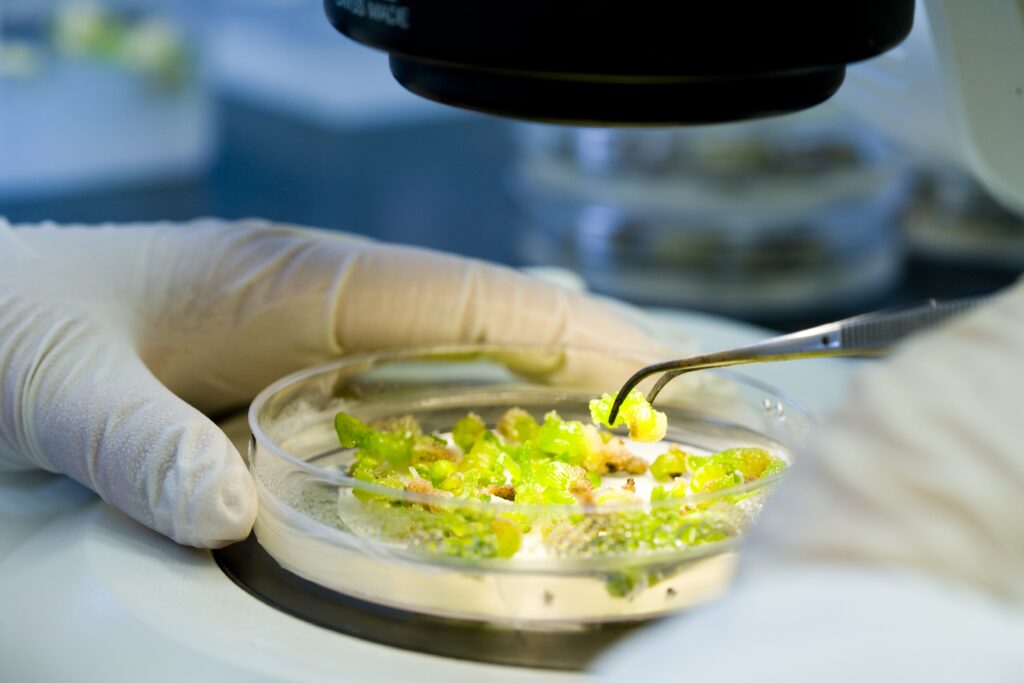New legislation now allows the growing of certain gene-edited crops in England. Professor Jonathan Jones, group leader at The Sainsbury Laboratory, Norwich, calls for a fresh approach to rules preventing the cultivation of GM crops. But Roger Kerr, chief executive at Organic Farmers & Growers urges caution over moves into new genetic technologies.

I’ve been using the GM method to confer specific traits on plants for 40 years. It enables benign and useful crop modifications to reduce the environmental impact of agriculture, especially by using genetics to replace the pest and disease control methods currently provided by agrochemistry. I’m still regularly astonished at the way this nature-based solution to crop improvement has been so misrepresented and vilified.
It is now more than 13 years since my team at The Sainsbury Laboratory in Norwich first conducted field trials of potatoes modified using the GM method to resist late blight disease. Those early trials were not near market – they only carried one resistance gene – but we now have Maris Piper lines with three resistance genes that are likely to remain resistant for a long time. Farmers currently spray around 15 times per year to control late blight. This requirement could be removed (although some sprays might still be required to control early blight).
The Conservative government pledged post-Brexit to liberate Britain’s “extraordinary” biosciences sector from the EU’s anti-GM rules, and “to develop the blight-resistant crops that will feed the world.” Might this finally become possible?
Credit where credit is due, of course. Through the Genetic Technologies (Precision Breeding) Act, the UK government has moved to exempt gene-edited crops from those restrictive GMO rules where they contain no foreign DNA or could have been obtained through ‘conventional’ breeding methods. This is great progress and I congratulate the ministers who made the decision to move this legislation forward and the hard-working and professional civil servants who implemented it.
The European Parliament has now voted to approve amendments to legislation on New Genetic Technologies (NGTs). The new framework for NGTs sets Europe on course to regulate certain gene-edited plants in the same way as their conventionally bred counterparts.

For crops developed using the GM method, by contrast, the mood remains decidedly frosty among lawmakers on the Continent, and still cautious in the UK.
Many of the politicians who argued in favour of the Precision Breeding Act sought to emphasise the distinction between GM and gene editing, with the clear implication that GM crops are in some way less desirable, or perhaps even more risky, than gene-edited crops. This view has zero scientific validity and is exasperating for plant scientists like me who have devoted their entire careers to using the method for crop improvement.
It ignores the fact that GM techniques can deliver outcomes that other crop-breeding technologies cannot, for example in areas such as more durable pest and disease resistance, photosynthetic efficiency, nitrogen fixation and adaptation to climate change and abiotic stresses. It also ignores the emerging evidence from modern genomics of massive structural and other genetic variation within our crops before they even get near any Agrobacterium that might modify them. Compared to pre-existing variation, the variation we introduce using either GE or GM methods is tiny; we have lost all sense of proportion.

When the GM method was first deployed, some thought there might be “unknown unknowns we didn’t even know we didn’t know about”. The “precautionary principle” was used to justify restrictive regulation of a crop improvement method that not only had never caused harm but had in fact resulted in benefits such as reduced insecticide applications. The precautionary principle understandably leads to regulation based on extreme risk aversion when knowledge is limited; such regulation should be reversible when decades of experience demonstrate that this risk aversion is no longer justified.
Scientific and regulatory agencies worldwide have repeatedly and consistently confirmed the safety of GM crops and foods. There has not been a single confirmed case of a negative health outcome for humans or animals from their consumption. Year after year, the technology has delivered significant economic and environmental benefits in those countries which have embraced its use. This scientific and empirical evidence has accumulated over almost 30 years from commercial cultivation and use of approved GM crops around the world, on a total area now exceeding 200 million ha.
In 2014, for example, a comprehensive meta-analysis of 147 studies found that growing GM crops helped reduced pesticide use by 37% while increasing crop yields (ie reducing the land required for crop production) by 22% and allowing more sustainable farming practices such as min- and no-till.

More recently, UK-based PG Economics concluded that GM crops have increased global food, feed and fibre production by nearly 1 billion tonnes (1996-2020), whilst helping farmers to reduce the environmental footprint associated with their crop protection practices by over 17%. The technology has also reduced carbon emissions, by an estimated 39.1 billion kilograms, arising from reduced fuel use of 14.7 billion litres and equivalent to removing 25.9 million cars from the roads.
These are hugely impressive results, but it turns out they represent only a fraction of the technology’s promise.
So while the adoption of GM crops has demonstrably contributed to increased crop yields, reduced pesticide use and lower carbon emissions, recent research published in the American Economic Review suggests that national bans or overly-restrictive rules on GM crop cultivation have also limited those global gains to just one-third of the technology’s potential. The study’s authors also note than poor countries would benefit most from lifting such restrictions.
That’s why the green NGOs campaigning against GM crops have so much to answer for. And why Nobel Laureate Sir Richard Roberts characterised Greenpeace’s opposition to Vitamin A-enriched Golden Rice as “a crime against humanity.”
It is also why the UK government should re-evaluate its implementation of current GM regulations and explore the potential for more proportionate risk assessment and data requirements, based on the specific properties conferred by each introduced trait, the intended use and the receiving agricultural environment.
Given the UK’s academic plant science and commercial plant-breeding expertise, the country has a great opportunity to use the GM method for the benefit of its citizens, to reduce the environmental and biodiversity impact of agriculture and to enhance international food security. It offers the potential to decrease the land required to meet our food needs and so free up more space for nature, decrease our dependence on food imports and our reliance on agrichemicals, and so decrease the economic and environmental costs of food production.
GM crop innovations developed in the UK are already being commercialised in other countries with more proportionate regulatory regimes. Outside the EU, the UK is no longer bound by an approach to regulation that is based on the scientifically unjustified idea that there are intrinsic risks in using the GM method. Instead, it can take advantage of the experience of almost 30 years of commercial use of GM crops to ensure its regulatory processes are proportionate to the potential for risks of specific traits in individual organisms, rather than the technology that delivers those traits.
Spurning the use of GM creates a substantial, and avoidable, opportunity cost, and that is why we urge the UK government to take a fresh look at the UK rulebook on using the GM method for crop improvement.
Organic advantage

With the government giving the green light to genetic modification (GM) in the Genetic Technology (Precision Breeding) Act 2023, it is now more critical than ever to ensure the implementation of this new legislation protects the integrity of crop and livestock genetics, the environment and human health.
As a consequence of the new legislation a robust regulatory framework surrounding this must be enforced to ensure the responsible roll out of this largely untested new technology.
The organic sector has successfully operated under such a regime for the last 30 years where assured food safety and supply chain integrity has taken precedence in ensuring consumer confidence.
Given genetic editing (GE) is a new, powerful and largely novel technology there is no arguable reason why genetic engineering should not have to comply with a stringent oversight regime to ensure the integrity of UK food and farming is protected.
While there is the possibility of genetic engineering advancing some genetic traits in crops and livestock, there is also the real potential for negative outcomes, a significant concern recognised by 88% of individuals and 64% of businesses who said they supported the continuing regulation of genetically modified organisms (GMOs).
The genetic composition of plants and animals has evolved to respond to the conditions they find themselves in and human intervention has sought to manipulate those traits that are advantageous through a natural process of selection.
Genetic engineering attempts to subvert this process through the introduction or silencing of genes through direct invasive manipulation of a plant or animal DNA. We are told this is natural, but that is far from being the case.
We simply cannot ignore the scientific evidence that genetic editing or modification has led to unintended consequences. This was the case of CRISPR-Cas being used to dehorn cattle in the US, which inadvertently introduced antimicrobial resistant genetic sequences.
The history of chemicals such as paraquat and DDT shows the dangers of releasing materials en masse into the environment when we do not fully understand their impact.

The problem with genetically engineered material is once it is released it cannot be withdrawn, as the material will have pervaded the environment and so the precautionary principle must be strongly adhered to.
Deliberate release of genetically edited materials must only be approved when a sufficient independent assessment has been made to ensure there are no risks of damage to human health or the natural environment.
Where a technology is unproven any use must be properly monitored to ensure an evaluation of their effects can be properly calculated over time.
Moreover, significant emphasis must be placed on whether any intended release is truly beneficial to the community and fulfils the necessary criteria for sustainable development.
OF&G is by no means anti-progress, but there is a lot more that can be done, indeed that is being done, before we reach for what some suggest is a ‘silver bullet’.
If we deal with the fundamental farming and societal issues first and get to 98% of where we need to be using nature-first approaches, and then GE takes us that last 2% over the line, that may be all for the better.
But starting with GE, thinking it is going to solve all our problems, is a back-to-front approach. Especially when there is a complete lack of any assessment (long- or short-term) into potential hazards to human health or the environment from its use.
Scientific research has shown the organic approach to food and farming helps by moving the damaging implications of over-production and over-consumption to within safe limits and planetary boundaries, balancing trade-offs in ways that are beneficial to the environment, while feeding the world.

The aim in organic food systems is to replace synthetic chemistry by working with and restoring natural ecosystems. The success of this approach is clear and evidenced by the successful work of organic farmers in the UK and around the world over many decades.
Natural plant-breeding methods have achieved much over many centuries and could achieve much more, especially when focused on less intensive and less extractive systems, where increased funding would provide further focus on the development of traits appropriate to restorative farming systems.
If 10% of English farmland was converted to organic as part of a wider multifunctional land use framework, it would deliver significant benefits. It is an area equivalent to a threefold increase from today’s 3.5% of land certified organic.
It is a relatively small percentage, but with enormous gains for the environment. It would result in a 3.64% decrease in English agriculture related greenhouse gas (GHG) emissions, which is equal to more than one million tonnes of CO₂e per year – the equivalent amount of carbon sequestered by a third of a million acres of broadleaved woodland while producing food.
Having no synthetic nitrogen applied across this 10% of English organic land would mean 9.4% reduction in total N consumption, which is equivalent to 179,000 tonnes less ammonium nitrate used per annum, while the removal of pesticides would mean taking out one million kg of insecticide, fungicide and herbicide active ingredients each year.

These are staggering figures that risk being overlooked by those blinkered by the GE promise.
This would also see farmland biodiversity restored in abundance – 78% more earthworm species, 35% more farmland birds, 23% more pollinators and 21% more field margin plant species, with soil biomass doubled.
The legally enforced organic regulation prohibits GE because it represents an unnatural and potentially environmentally destructive approach to food production.
Choosing organic represents an opportunity for shoppers to avoid consuming genetically altered food, assuming Government brings in coexistence legislation that ensures the effective separation of GE and non-GE derived foods. By doing so, this would give citizens the ability to decide whether they want to consume foods containing GE derived ingredients or not.
To that end, considered and progressive policies from government that support UK farming in delivering climate-friendly, people-positive food production and a real commitment to a consistent, thorough and well-resourced system-wide strategy is necessary.
This, alongside rigorous independent oversight and a clear definition of those technologies that represent a possible risk to the environment and human health.
Indeed, all these factors working together are going to be fundamental to this country’s ability to feed ourselves and protect our natural and farmed landscapes through what is predicted to be a very turbulent time for us all.



